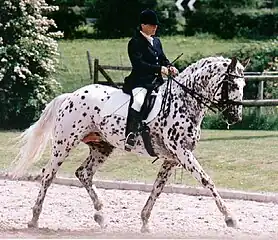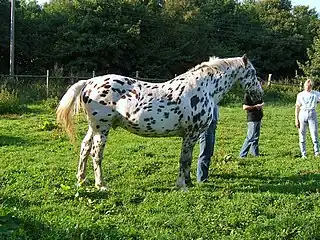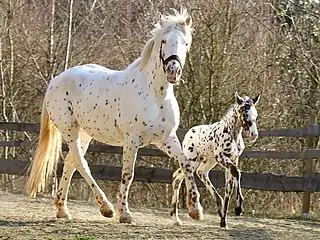 | |
| Conservation status | |
|---|---|
| Other names |
|
| Country of origin | Denmark |
| Distribution |
|
| Standard | |
| Use | Riding, driving, circus |
| Traits | |
| Weight |
|
| Height | |
| Colour | Any but piebald or palomino; often spotted[2] |
The Knabstrupper or Knabstrup is a Danish breed of warmblood horse. It is principally a riding horse, but is also used as a harness horse and as a circus animal.[6]: 64
It is broadly similar to the Frederiksborger, but often has a spotted coat. Injudicious breeding for this characteristic alone compromised its constitution and conformation;[7]: 113 [8]: 176 in the years after the Second World War the mechanisation of agriculture led to a sharp fall in numbers, and by the 1960s no more than 100 examples remained.[9] In the twenty-first century it is an endangered breed, with a world-wide population estimated at little over 2000.[2]
History
The Knabstrupper descends from single mare, believed to have originated in Spain, who showed qualities of endurance and speed and was of a most unusual colouration: she was a deep red (German: Zobelfuchs) with a white tail and mane, and white flecks or "snowflakes" over her whole body and brown spots on her back.[5]: 480 She was called Flaebehoppen, 'Flaebe's horse', because she was reportedly bought by a butcher named Flaebe from an officer of the Spanish army. He sold her to Willars Knudsen Lunn, who took her to his estate at Knabstrup Hovedgård in the kommune of Holbæk in northern Zealand.[8]: 176 There, in 1808, after a month of testing of her working capabilities, he bred her to a Frederiksborger stallion.[5]: 480 [7]: 113 The stallion Mikkel, a grandson of this pair foaled in 1818, was a noted harness-racer and a foundation stallion of the Knabstrupper breed.[5]: 480 [7]: 113 [8]: 176
This breed was once very popular, but later was crossbred with other horses, and whether any purebreds from this breed remain is not certain. They do well in dressage and show jumping, and are used in general riding and driving, and as circus horses.[10] In 1971, three Appaloosa stallions were imported to Denmark to add new blood to the Knabstrupper breed.[11]
Knabstruppers today are bred in Denmark, Norway, Sweden, Switzerland, Italy, Germany, Netherland, the United Kingdom, the United States, and most recently, the Czech Republic, Australia, New Zealand, and Canada.[12]
Characteristics
The breed is usually around 15.2 to 16 h (62 to 64 inches, 157 to 163 cm), but also pony-sized ones (under 14.2 h (58 inches, 147 cm) are found. Coat patterns range from solid to a full leopard-spotted coat, with many variants in between. The spotted coat is caused by a genetic mechanism called the leopard complex. The spotted color patterns common in the Knabstrupper are seen in other breeds, such as the Appaloosa horse, though the two breeds developed independently of one another. The breed generally has either warmblood or Baroque horse conformation.
Some Knabstruppers are born with solid colors, such as bay or chestnut.[13]
Gallery
 Stallion Hamlet Frydenlund
Stallion Hamlet Frydenlund Stallion Baron Aus Der Schuetzenden Hand
Stallion Baron Aus Der Schuetzenden Hand Stallion Xantos
Stallion Xantos Mare and foal
Mare and foal
References
- ↑ Barbara Rischkowsky, Dafydd Pilling (editors) (2007). List of breeds documented in the Global Databank for Animal Genetic Resources, annex to The State of the World's Animal Genetic Resources for Food and Agriculture. Rome: Commission on Genetic Resources for Food and Agriculture, Food and Agriculture Organization of the United Nations. ISBN 9789251057629. Archived 23 June 2020.
- 1 2 3 4 5 6 Breed data sheet: Knabstrupper / Denmark (Horse). Domestic Animal Diversity Information System of the Food and Agriculture Organization of the United Nations. Accessed September 2022.
- ↑ Breed data sheet: Knabstrupper / Germany (Horse). Domestic Animal Diversity Information System of the Food and Agriculture Organization of the United Nations. Accessed September 2022.
- ↑ Transboundary breed: Knabstrupper. Domestic Animal Diversity Information System of the Food and Agriculture Organization of the United Nations. Accessed September 2022.
- 1 2 3 4 Valerie Porter, Lawrence Alderson, Stephen J.G. Hall, D. Phillip Sponenberg (2016). Mason's World Encyclopedia of Livestock Breeds and Breeding (sixth edition). Wallingford: CABI. ISBN 9781780647944.
- ↑ Élise Rousseau, Yann Le Bris, Teresa Lavender Fagan (2017). Horses of the World. Princeton: Princeton University Press. ISBN 9780691167206.
- 1 2 3 Elwyn Hartley Edwards (1994). The Encyclopedia of the Horse. London; New York; Stuttgart; Moscow: Dorling Kindersley. ISBN 0751301159.
- 1 2 3 Elwyn Hartley Edwards (2016). The Horse Encyclopedia. New York, New York: DK Publishing. ISBN 9781465451439.
- ↑ Irina Wenk (2020). The ideal horse: politics and practices of Knabstrupper breeding. In: Kristen Guest, Monica Mattfeld (editors) (2020). Horse Breeds and Human Society: Purity, Identity and the Making of the Modern Horse. Abingdon; New York: Routledge. ISBN 9781032084428.
- ↑ "Knabstrup". horse-owners-world.co.uk. 2007. Archived from the original on 25 November 2010. Retrieved 2 August 2009.
- ↑ "History". Knabstrupperforeningen for Danmark. Retrieved 6 October 2023.
- ↑ "Tiara Equine - The Source for Knabstruppers in Canada". Tiara Equine. Retrieved 29 September 2020.
- ↑ "Knabstrup". horsebreedslist.com. Retrieved 2 August 2009.